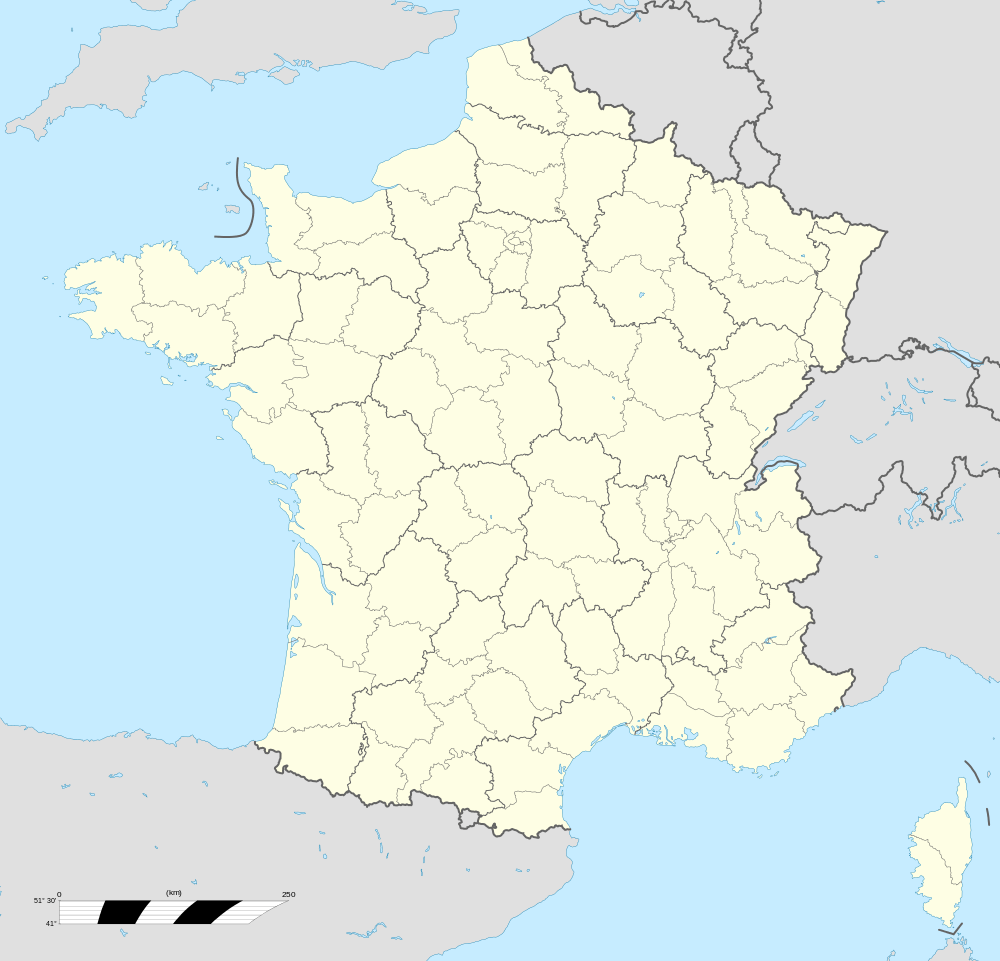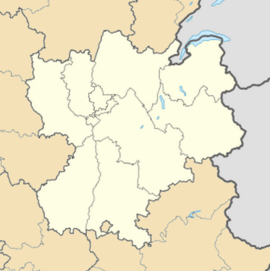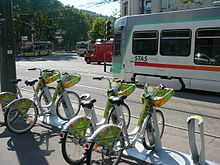Saint-Étienne
| Saint-Étienne | ||
|---|---|---|
|
Overview of Saint-Étienne | ||
| ||
 Saint-Étienne | ||
|
Location within Rhône-Alpes region  Saint-Étienne | ||
| Coordinates: 45°26′05″N 4°23′25″E / 45.4347°N 4.3903°ECoordinates: 45°26′05″N 4°23′25″E / 45.4347°N 4.3903°E | ||
| Country | France | |
| Region | Rhône-Alpes | |
| Department | Loire | |
| Canton | Chief town of 9 cantons | |
| Intercommunality | Saint-Étienne Métropole | |
| Government | ||
| • Mayor (2014-2020) | Gaël Perdriau (UMP) | |
| Area1 | 79.97 km2 (30.88 sq mi) | |
| Population (2007 estimate)2 | 178,530 | |
| • Rank | 16th in France | |
| • Density | 2,200/km2 (5,800/sq mi) | |
| Time zone | CET (GMT +1) | |
| INSEE/Postal code | 42218 / 42000, 42100 | |
| Elevation |
422–1,117 m (1,385–3,665 ft) (avg. 516 m or 1,693 ft) | |
| Website | http://www.saint-etienne.fr/ | |
|
1 French Land Register data, which excludes lakes, ponds, glaciers > 1 km² (0.386 sq mi or 247 acres) and river estuaries. 2 Population without double counting: residents of multiple communes (e.g., students and military personnel) only counted once. | ||
Saint-Étienne (French pronunciation: [sɛ̃t‿etjɛn]; Arpitan: Sant-Etiève; Saint Stephen) is a city in eastern central France. It is located in the Massif Central, 50 km (31 mi) southwest of Lyon in the Rhône-Alpes region, along the trunk road that connects Toulouse with Lyon. Saint-Étienne is the capital of the Loire département and has a population of approximately 178,500 in the city itself expanding to over 508,000 in the metropolitan area (2011).
History
Named after Saint Stephen, the city first appears in the historical record in the Middle Ages as Saint-Étienne de Furan (after the River Furan, a tributary of the Loire). In the 13th century it was a small borough around the church dedicated to Saint Etienne. On the upper reaches of the Furan near the Way of St. James the Abbey of Valbenoîte had been founded by the cistercians in 1222. In the late 15th century it was a fortified village defended by walls built around the original nucleus.
From the 16th century, Saint-Étienne developed an arms manufacturing industry and became a market town. It was this which accounted for the town's importance, although it also became a centre for the manufacture of ribbons and passementerie starting in the 17th century. During the French revolution, Saint-Étienne was briefly renamed Armeville – 'arms town' – because of this activity.
Later, it became a mining centre of the Loire coal mining basin, and more recently has become known for its bicycle industry.
In the first half of the 19th century it was only a chief town of an arrondissement in the département of the Loire, with a population of 33,064 in 1832. The concentration of industry prompted these numbers to rise rapidly to 110,000 by about 1880. It was this growing importance of Saint-Étienne that led to its being made seat of the prefecture and the departmental administration on 25 July 1855, when it became the chief town in the département and seat of the prefect, replacing Montbrison, which was reduced to the status of chief town of an arrondissement. Saint-Étienne absorbed the commune of Valbenoîte and several other neighbouring localities on 31 March 1855.
Demographics
Population of the city at the 1999 census was 180,210 (177,300 as of February 2004 estimates). Population of the whole metropolitan area at the 1999 census was 321,703.
Inhabitants of Saint-Étienne are called Stéphanois in French. They are named so because "Étienne" derives from the Greek Stephanos.
Culture
Saint-Étienne became a popular stop for automobile travelers in the early 20th century (sometimes referred to as The Golden Age of Travel[1]).
In 1990 Saint-Étienne set up a design biennale – the largest of its kind in France. It lasts around two weeks. The last convention was in March 2013.[2] A landmark in the history of the importance ascribed to design in Saint-Étienne was the inauguration of La Cité du design on the site of the former arms factory in 2009.
The city also launched the Massenet Festivals, (the composer Jules Massenet hailed from the area) devoted mainly to perform Massenet's operas. In 2000 the city was named one of the French Towns and Lands of Art and History. On 22 November 2010, it was nominated as "City of Design" as part of Unesco’s Creative Cities Network.[3]
Saint-Étienne has three museums:
- the Musée d'Art Moderne has one of the largest collections of modern and contemporary art in France
- Musée de la Mine
- Musée de l'Art et de l'Industrie
Sport
The city's football club AS Saint-Étienne has won the Ligue 1 title a record ten times, achieving most of their success in the 1970s. British indie-dance band Saint Etienne named themselves after the club.
St. Étienne was the capital of the French bicycle industry. The bicycle wheel manufacturer Mavic is based in the city and frame manufacturers Motobécane and Vitus are also based here. The city often hosts a stage of the Tour de France.
St. Étienne resident Thierry Gueorgiou is a world champion in orienteering. The local rugby union team is CA Saint-Étienne Loire Sud Rugby.
Transport




The nearest airport is Saint-Étienne - Bouthéon Airport which is located in Andrézieux-Bouthéon, 12 km (7.46 mi) north-northwest of Saint-Étienne. The main railway station is Gare de Saint-Étienne-Châteaucreux, which offers high speed services to Paris and Lyon (Saint-Étienne–Lyon railway) and several regional lines.
Saint-Étienne is also notable for its tramway (Saint-Étienne tramway) – which uniquely with Lille, it kept throughout the 20th century – and its trolleybus system (Saint-Étienne trolleybus system) – which is one of only three such systems currently operating in France.
Bus and tram transport is regulated and provided by the Société de Transports de l'Agglomération Stéphanoise (STAS), a public transport executive organisation.
The bicycle sharing system Vélivert with 280 short term renting bicycles is available since June 2010.
Colleges and universities
- Jean Monnet University
- École Nationale Supérieure des Mines de Saint-Étienne (EMSE or ENSMSE)
- École nationale d'ingénieurs de Saint-Étienne (ENISE)
- Telecom Saint Etienne (TSE)
- ESC Saint-Etienne
- ENSASE (Ecole National Supérieure d'Architecture de Saint-Étienne)
Notable people
Saint-Étienne was the birthplace of
- René Diaz - French journalist and illustrator
- Augustin Dupré (1748–1833) engraver of French coins and medals, France's 14th Graveur général des monnaies
- Claude Fauriel (1772–1844), historian, philologist and critic.
- Saint Marcellin Champagnat (1789–1840), a Catholic priest and founding members of the Society of Mary (Marist Fathers) who founded the Marist Brothers and was canonised in 1999.
- Antonin Moine (1796–1849), sculptor
- Jules Janin (1804–1874), writer and critic.
- Francis Garnier (1839–1873), officer and explorer who explored the Mekong River, much to the surprise of the inhabitants.
- Jules Massenet (1842–1912), composer best known for his operas.
- Paul de Vivie, aka Velocio (1853–1930) publisher of Le Cycliste, early champion of the dérailleur and father of French cycle touring.
- Claudine Chomat (1915–1995), member of the French Resistance during World War II, feminist, communist activist
- Bernard Lavilliers (b. 1946) (Bernard Ouillon), singer.
- Orlan (1947–), contemporary artist
- Willy Sagnol (b. 1977) French International Football Player
- Jean Guitton (1901–1999) a Catholic philosopher and theologian.
- Thierry Gueorgiou (b. 1979), Orienteering world champion
- Norma Ray singer
- Alexis Ajinca basketball player
- Sylvain Armand footballer
- Sliimy singer
- Aravane Rezai tennis player
- Loïc Perrin footballer
It was also the place where Andrei Kivilev died.
International relations
Saint-Étienne is twinned with:
|
See also
- Manufacture d'armes de Saint-Étienne
- Stade Geoffroy-Guichard
- Saint-Étienne Cathedral
- Saint-Étienne – Gorges de la Loire Nature Reserve
- André César Vermare Sculptor of Franco-Prussian war memorial.
References
- Notes
- ↑ "LAPL Virtual Photo: Far and Wide". Lapl.org. Retrieved 14 June 2010.
- ↑ "Cité du design | Biennale | L'Édition 2013". Citedudesign.com. Retrieved 2013-03-12.
- ↑ St-Etienne and Sydney nominated UNESCO Creative Cities , 22 November 2010.
- ↑ Griffin, Mary (2011-08-02). "Coventry's twin towns". Coventry Telegraph. Retrieved 2013-08-06.
- ↑ "Coventry - Twin towns and cities". Coventry City Council. Archived from the original on 2013-04-14. Retrieved 2013-08-06.
- ↑ "British towns twinned with French towns". Archant Community Media Ltd. Retrieved 2013-07-11.
External links
| Wikimedia Commons has media related to Saint-Étienne. |
| ||||||
